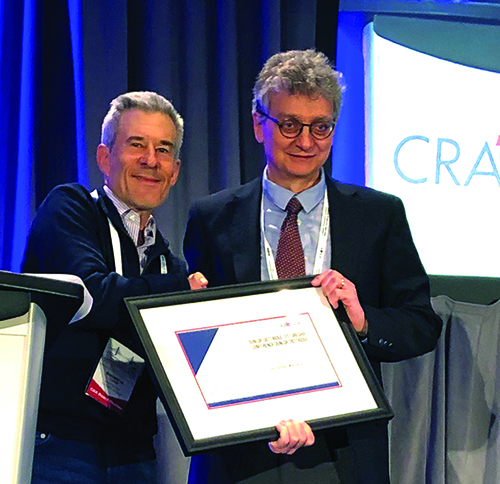Summer 2019 (Volume 29, Number 2)
The 4 H’s of Biomarkers:
Help, Harm, Hype & Hope
By Gilles Boire, Dunlop-Dottridge Lecturer
Download PDF
It was an honour to present the 2019 Dunlop-Dottridge
Lecture in Montréal. I am an academic adult rheumatologist
(also treating kids with rheumatic conditions) and a
researcher in Sherbrooke, Québec. Mentors André Lussier
and Henri H. Ménard in Sherbrooke, and Joe Craft and
John Hardin at Yale University, introduced me to scientific
rheumatology. My research has evolved from fundamental
work on autoantigen/antibody systems to translational
work on prognostic biomarkers in recent-onset inflammatory
polyarthritis.
The ABC’s of Biomarkers
Biomarkers are variables that can be objectively measured
from fluids, such as blood or urine, from cells or tissues,
from imaging, and even from your smart watch. They are
used for diagnostic, prognostic or pathogenic purposes, or
to monitor disease activity, treatment response or toxicity.
Variables indicative of patients’ feelings, well-being or
functional status are NOT biomarkers. A biomarker may
consist of a single variable or summarize multiple variables
(then called a composite). The ideal biomarker informs
clinical management, and is safe, easy to measure, sensitive,
specific, reproducible, consistent across gender and
race, and cost-efficient. Biomarkers are frequently correlated
(e.g. C-reactive protein [CRP] and erythrocyte sedimentation
rate [ESR]), and the information they generate may
be redundant.
Current Biomarkers
Problems arise when the presence or absence of a biomarker
takes precedence over the clinical characteristics.
Healthy individuals may be labelled at risk for disease
development, generating unnecessary anxiety and
potential harm. Conversely, absent biomarkers may delay
correct diagnosis. Sometimes biomarkers point in the
wrong direction. It is thus critical to carefully consider
all clinical findings when ordering and interpreting
biomarkers, as the Choosing Wisely Canada campaign
suggests.
Unrelated changes in practice may alter the course of
disease and the pertinence of some biomarkers; similarly,
a widely used biomarker may induce changes in care that
may blunt its original impact. Finally, biomarkers do not
holistically represent the actual patients; remember the
importance of patient-derived variables.
Next-Generation
Computational
Biomarkers
Computational biomarkers originate from extremely rich
data generated by ever more efficient molecular technologies,
such as high throughput DNA sequencing, single cell
gene expression, and microbiome and epigenetic studies.
Making sense of such a large volume of data (big data) requires
advanced statistical methods and techniques well
beyond the typical clinician’s understanding. Reliance on
multiple parameters raises the potential for hidden correlations
(e.g. microbiota and host genetics), complicating
their use in combination with current or other next-generation
biomarkers (MultiOmics), clinical parameters, and
patient-related outcomes.
My presentation aimed at informing how much technology-driven biomarkers in development differ from the simple
ones currently in use and how similar their evaluation
should be.
The major difference is that computational biomarkers
may inform beyond the crude tools of clinical evaluation,
leading to a better understanding of the complex interaction
of genes and environment that cause dysregulation of underlying
disease. They help to classify patients into narrower,
more homogeneous groups, paving the way to personalized
medicine tailored to individuals rather than groups; prevention
and cure then become potentially more accessible.
The similarity is that an incomplete evaluation of computational
biomarkers may harm more than help. Lessons
from the past tell us that biomarkers are subject to manipulation,
leading to unfavourable outcomes despite increased
costs. We will need to evaluate the proposed uses of candidate
next-generation biomarkers in well characterized cohorts
followed over a long period, to ensure that they are
appropriate and result in improved outcomes.
For sure, the next generation of biomarkers based on
big data heralds a new, exciting, yet controversial era for
rheumatology.

Gilles Boire, MD, MSc, FRCPC
Rheumatologist,
Department of Medicine, Faculty of Medicine and Health Sciences,
Université de Sherbrooke
Centre intégré universitaire de santé et de services sociaux de l’Estrie –
Centre hospitalier universitaire de Sherbrooke (CIUSSS de l'Estrie-
CHUS)
Sherbrooke, Québec
|
